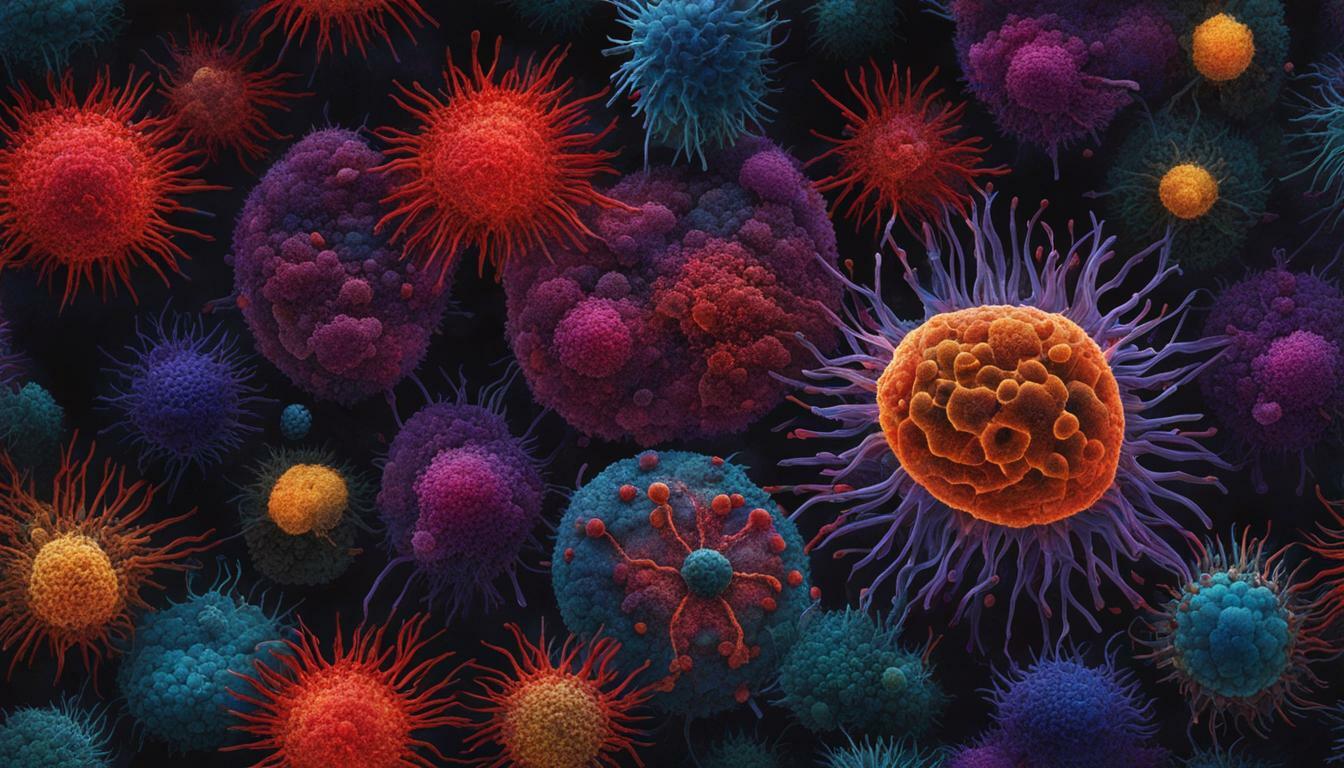The presence of pathogens in the body has been a subject of interest when it comes to understanding the causes of migraines. Research and scientific studies have explored the potential link between migraines, sore muscles, athlete’s foot, and mental illness with the presence of pathogens. This article aims to delve deeper into this topic and provide insights into whether these conditions are indeed caused by pathogens.
Key Takeaways:
- The relationship between migraines, sore muscles, athlete’s foot, and mental illness and the presence of pathogens is a subject of ongoing research.
- Studies have explored the potential link between pathogens and these conditions, but conclusive evidence is still needed.
- Excessive sweating caused by hyperhidrosis can lead to skin problems such as maceration, jock itch, athlete’s foot, body odor, warts, and bacterial infections.
- Social and emotional complications, as well as psychological distress, can arise from excessive sweating and its impact on daily life.
- Further research is needed to fully understand the role of pathogens in the development of migraines, sore muscles, athlete’s foot, and mental illness.
The Link Between Pathogens and Migraines, Sore Muscles, Athlete’s Foot, and Mental Illness
Several studies have suggested a possible link between the presence of pathogens and the development of migraines. Research has shown that certain pathogens, such as viruses and bacteria, may trigger migraines in susceptible individuals. For example, a study published in the Journal of Translational Medicine found a potential association between chronic viral infections and myalgic encephalomyelitis/chronic fatigue syndrome (ME/CFS), a condition characterized by severe fatigue and muscle pain.
In addition to migraines, pathogens have also been implicated in other conditions such as sore muscles, athlete’s foot, and mental illness. The Mayo Clinic Proceedings reported that infections, including those caused by pathogens, were among the most prevalent conditions seen in a defined American population. This suggests a potential connection between pathogens and these health issues.
Pathogens can affect the body in various ways, leading to the development of these conditions. For instance, certain viruses can directly invade the nervous system and trigger inflammation, which may contribute to migraines. Similarly, bacterial infections can cause inflammation and damage to muscle tissue, leading to sore muscles. In the case of athlete’s foot, a fungal infection, the pathogen thrives in a moist environment, making excessive sweating a contributing factor.
Table: Examples of Pathogens and Their Associated Conditions
| Pathogen | Associated Condition |
|---|---|
| Viruses | Migraines, mental illness |
| Bacteria | Sore muscles |
| Fungi | Athlete’s foot |
It is important to note that while these studies suggest a potential link between pathogens and these conditions, more research is needed to establish a definitive causal relationship. Nonetheless, understanding the potential role of pathogens in migraines, sore muscles, athlete’s foot, and mental illness can help inform future research and guide the development of targeted treatments.
Pathogens and Migraines
Various pathogens, such as viruses and bacteria, have been suggested to play a role in the development of migraines. Research has shown that certain infections can trigger migraines in susceptible individuals. For example, viral infections like the flu or common cold have been associated with an increased risk of developing migraines. Additionally, bacterial infections, such as sinusitis or urinary tract infections, have also been linked to migraines.
A study published in the Journal of Neuroimmunology investigated the role of viral infections in migraines and found that certain viruses, such as the Zika virus, can directly affect the central nervous system and trigger migraines. The study highlighted the importance of considering viral infections as a potential cause of migraines.
Furthermore, a prospective cohort study published in the BMJ suggested that post-infectious fatigue syndromes caused by viral and non-viral pathogens, such as Epstein-Barr virus or cytomegalovirus, may be associated with the development of migraines. This study indicated that infections can have long-lasting effects on the body, potentially leading to migraines in some individuals.
Pathogens and Migraines: Mechanisms and Future Research
While the exact mechanisms by which pathogens contribute to migraines are still being studied, several hypotheses have been proposed. It is believed that pathogens can cause inflammation and alter the functioning of the immune system, leading to the development of migraines. Additionally, viruses and bacteria may directly affect the blood vessels and nerves in the head, triggering migraine attacks.
Future research is needed to further understand the relationship between pathogens and migraines. This could involve studying the specific types of pathogens that are most commonly associated with migraines and identifying the underlying mechanisms by which they contribute to the condition. By gaining a better understanding of these factors, researchers may be able to develop more targeted treatments for migraines and improve the overall management of this debilitating condition.
| Source | Summary |
|---|---|
| Journal of Neuroimmunology | Investigated the role of viral infections in migraines and found that certain viruses, such as the Zika virus, can directly affect the central nervous system and trigger migraines. |
| BMJ | Suggested that post-infectious fatigue syndromes caused by viral and non-viral pathogens may be associated with the development of migraines. |
In conclusion, there is evidence to suggest a potential link between pathogens, including viruses and bacteria, and the development of migraines. While further research is needed to fully understand the mechanisms and specific pathogens involved, these findings highlight the importance of considering infections as potential triggers for migraines. By uncovering the underlying mechanisms, researchers may be able to develop more targeted treatments for migraines in the future.
Pathogens and Sore Muscles, Athlete’s Foot, and Mental Illness
There is growing evidence to suggest that certain pathogens may play a role in the development of conditions such as sore muscles, athlete’s foot, and mental illness. Research has shown that various pathogens, including viruses and bacteria, can have implications for these conditions. Let’s explore some of the key findings.
Sore Muscles
One study published in the European Spine Journal found that chronic physical illnesses, mental health disorders, and psychological features are potential risk factors for back pain, which can often result in sore muscles. The study highlighted the complex interactions between physical and mental health, suggesting that pathogens could contribute to the development or exacerbation of sore muscles through their impact on overall health and immune function.
Athlete’s Foot
Athlete’s foot, a fungal infection of the feet, is often associated with excessive sweating and moist conditions. Fungal pathogens, such as those responsible for athlete’s foot, thrive in such environments. The continuous moisture created by heavy sweating can increase the likelihood of developing athlete’s foot. It is important to keep the feet clean and dry to help prevent this condition.
Mental Illness
Research has also explored the potential link between pathogens and mental illness. Studies have suggested that viral infections, such as those caused by the Zika virus, can have neurological effects and contribute to the development of mental health disorders. Additionally, chronic viral infections, including those associated with myalgic encephalomyelitis/chronic fatigue syndrome, have been implicated in the development of mental health symptoms.
It is worth noting that the exact mechanisms by which pathogens may contribute to these conditions are still being investigated. However, the available evidence suggests that pathogens can have a role in the development or exacerbation of sore muscles, athlete’s foot, and mental illness. Further research is needed to better understand these relationships and identify potential treatment strategies.
| Condition | Pathogens |
|---|---|
| Sore Muscles | Various pathogens, including viruses and bacteria |
| Athlete’s Foot | Fungal pathogens |
| Mental Illness | Viral infections and chronic viral infections |
In conclusion, while more research is needed, the available evidence suggests a potential role for pathogens in the development of sore muscles, athlete’s foot, and mental illness. Understanding these connections can help inform prevention and treatment strategies for these conditions. It is important for individuals experiencing symptoms to consult with healthcare professionals for proper diagnosis and management.
Conclusion
While the research on the association between pathogens and migraines, sore muscles, athlete’s foot, and mental illness is still evolving, there is evidence to suggest a potential link between these conditions and the presence of pathogens. Multiple studies have explored the role of pathogens in these conditions, and although more research is needed to fully understand the mechanisms involved, the findings are intriguing.
For migraines, certain types of pathogens, such as viruses and bacteria, have been implicated. These pathogens may trigger an immune response in the body, leading to inflammation and the subsequent development of migraines. Additionally, viral infections have been associated with an increase in pain sensitivity, which may contribute to the severity of migraines.
When it comes to conditions like sore muscles, athlete’s foot, and mental illness, there is also some evidence suggesting a potential connection to pathogens. Inflammatory responses triggered by infections can lead to muscle soreness, while fungal infections like athlete’s foot thrive in moist environments created by excessive sweating. Furthermore, studies have shown a link between certain viral infections and the development of mental health disorders.
It is important to note that the presence of pathogens alone may not be the sole cause of these conditions. Other factors, such as genetics, lifestyle, and environmental triggers, may also play a role. However, the potential link between pathogens and these conditions highlights the need for further research and a better understanding of the underlying mechanisms.
In conclusion, while more research is needed, the available evidence suggests that pathogens may have a role in the development of migraines, sore muscles, athlete’s foot, and mental illness. Understanding the relationship between pathogens and these conditions could potentially lead to new prevention strategies and treatments in the future.
FAQ
Q: Is migraines caused by pathogens?
A: Currently, there is no conclusive evidence to suggest that migraines are caused by pathogens. Migraines are complex neurological conditions that can be influenced by various factors, including genetics, hormones, and environmental triggers. While some studies have explored the potential role of pathogens in migraines, more research is needed to establish a definitive link.
Q: Are sore muscles caused by pathogens?
A: Sore muscles, also known as muscle pain or myalgia, are typically caused by overexertion, injury, or inflammation of the muscles. While infections caused by certain pathogens can lead to muscle pain as a symptom, it is not commonly attributed to pathogens as the primary cause. If you are experiencing persistent or severe muscle pain, it is important to consult a healthcare professional for an accurate diagnosis.
Q: Is athlete’s foot caused by pathogens?
A: Yes, athlete’s foot is a fungal infection caused by a pathogen called dermatophytes. These fungi thrive in warm, moist environments such as locker rooms and swimming pools. Athlete’s foot can cause itching, redness, and flaking of the skin on the feet. Proper hygiene and avoiding walking barefoot in public areas can help prevent the spread of the infection.
Q: Is mental illness caused by pathogens?
A: The exact causes of mental illnesses such as depression, anxiety disorders, and schizophrenia are not fully understood. While some studies have suggested a potential link between certain pathogens and mental health conditions, the relationship is complex and multifactorial. Mental illnesses are believed to arise from a combination of genetic, environmental, and psychological factors. It is important to seek professional help if you or someone you know is struggling with mental health issues.





